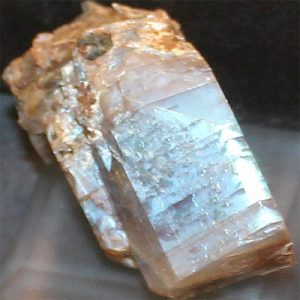Sanidine (Feldspar)
Sanidine is a member of the alkali, or potassium Feldspars (K-Feldspars) of the Feldspar Group of minerals that includes Albite, Amazonite, Andesine, Anorthite, Bytownite, Hyalophane, Labradorite, Moonstone, Oligoclase, Orthoclase, Sanidine, and Sunstone. The K-Feldspars include Anorthoclase, Microcline, Orthoclase, and Sanidine. Sanidine forms a series with Albite with Sanidine being the potassium (K) rich end member and Albite being the sodium (Na) rich end member and Anorthoclase being an intermediate member with about 10 to 36% sodium content. Sanidine is typically found in felsic volcanic rocks such as obsidian, rhyolite, and trachyte.
Sanidine was named in 1808 by Karl Wilhelm Nose (1753-1835) from the Greek words σάνις (sanis) meaning tablet and ιδος (idos) meaning to appear in allusion to the mineral’s common flattened, tabular crystal habit. Sanidine was described by Nose as glassy tabular crystals from volcanic rocks of the lower Rhine Valley, Germany.
Sanidine is a fairly rare mineral and even rarer as a faceted gem as crystals are rarely large enough for faceting. It is found in several locations around the world but the main source of Sanidine gems is Itrongay, Mahasoa East Commune, Betroka District, Anosy Region, Tuléar Province, Madagascar. Large, gem quality crystals from this location have been found in bright yellow to straw yellow and greenish-yellow crystals up to about 100 carats from as early as the early 1900’s. Until recently these crystals (and gems) were incorrectly labeled as “Orthoclase” instead of Sanidine. Sanidine gems from Madagascar are exceptional in their size, clarity, saturation, and uniformity of color.
Sanidine distribution: Not uncommon, but rare in crystals of any size. In Germany, from Drachenfels, Siebengebirge, Rhine; and at Hohenfels, Mendig, Mayen, and elsewhere around the Laacher See, Eifel district. In France, at Mt. Dore, Auvergne, and Puy Gros du Laney, Puy-de-Dôme. From Vesuvius and Monte Somma, Campania, and Monte Cimine, Lazio, Italy. At Daichi, Wakayama Prefecture, Japan. From Kanchin-do, Meisem-gun, northeast Korea. In the USA, at Tooele, Tooele County, Utah; Cottonwood Canyon, Peloncillo Mountains, Cochise County, Arizona; as large crystals in Rabb Canyon and near the crest of the Black Range, Grant County, New Mexico. From Bernic Lake, Manitoba, and Mont Saint-Hilaire, Quebec, Canada. In Mexico at the (early 1990’s) Pili Mine, Mun. de Saucillo, Chihuahua, and at Sierra de San Francisco, Durango. At Itrongay, Mahasoa East Commune, Betroka District, Anosy Region, Tuléar Province, Madagascar.
| Chemical Formula: | (K,Na)(Al,Si)4O8 |
| Potassium Sodium Aluminum Silicate | |
| Molecular Weight: | 274.30 gm |
| Composition: | Potassium | 10.69 % | K | 12.88 % | K2O |
| Sodium | 2.10 % | Na | 2.82 % | Na2O | |
| Aluminum | 9.84 % | Al | 18.59 % | Al2O3 | |
| Silicon | 30.72 % | Si | 65.71 % | SiO2 | |
| Oxygen | 46.66 % | O | |||
| 100.00 % | 100.00 % | = TOTAL OXIDE |
| Crystallography: | Monoclinic – Prismatic |
| Crystal Habit: | Crystals commonly tabular on {010}, with a square cross-section, to 50 cm. Acicular in spherulites. |
| Twinning: | Carlsbad twins are common, Baveno and Manebach twins rarer |
| Cleavage: | Perfect on {001}, distinct on {010}; parting on {100} |
| Fracture: | Irregular/uneven, Conchoidal |
| Tenacity: | Brittle |
| Moh’s Hardness: | 6.0 |
| Density: | 2.56 – 2.62 (g/cm3) |
| Luminescence: | None |
| Radioactivity: | Barely Detectable; GRapi = 152.94 (Gamma Ray American Petroleum Institute Units) |
| Color: | Colorless, white, gray, yellowish white, reddish white, very rarely blue (Azulicite); colorless in thin section |
| Transparency: | Transparent to translucent |
| Luster: | Vitreous, pearly on cleavages |
| Refractive Index: | 1.518 – 1.531 Biaxial ( – ) |
| Birefringence: | 0.006 – 0.007 |
| Dispersion: | Weak; r < v or r > v |
| Pleochroism: | None |


